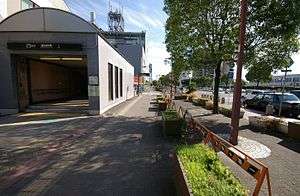Minato Kuyakusho Station
Minato Kuyakusho Station (港区役所駅, Minato Kuyakusho-eki) is an underground railway station on the Meikō Line in Minato-ku, Nagoya, Aichi Prefecture, Japan, operated by Nagoya Municipal Subway. It is numbered "E05".
Minato Kuyakusho Station 港区役所駅 | |
|---|---|
 Exit 1 and surrounding area | |
| Location | 1-14-20 Kōraku, Minato, Nagoya, Aichi (名古屋市港区港楽一丁目14-20) Japan |
| Operated by | Transportation Bureau City of Nagoya |
| Line(s) | Meikō Line |
| Connections |
|
| Other information | |
| Station code | E5 |
| History | |
| Opened | 1971 |
| Traffic | |
| Passengers (FY2008) | 1,235,690[1] |
Lines
Minato Kuyakusho Station is served by the Meikō Line, and lies 4.6 km from the terminus of the Meikō Line at Kanayama Station.
Layout
Minato Kuyakusho Station has two underground opposed side platforms. There is one set of ticket barriers, beyond which there are two exits. Each platform has an elevator, and Platform 1 for Nagoyakō Station has an up escalator and Platform 2 for Kanayama Station has a down escalator. Beyond the gates are two exits, Exit 1 and Exit 2. Near Exit 2 is a public telephone. There are universal access toilets with a baby changing area.
Platforms
| 1 | ■ Meikō Line | for Nagoyakō |
| 2 | ■ Meikō Line | for Kanayama, Sakae, and Ōzone |
On Platform 1 for Nagoyakō Station, train door 13 is closest to the elevator, door 12 is closest to the escalator, and doors 5 and 12 are closest to the stairs. On the opposite platform, Platform 2 for Kanayama Station, train door 14 is closest to the elevator and doors 7 and 14 are closest to the stairs.[2][3]
History
Minato Kuyakusho Station was opened on 29 March 1971.
Surrounding area
This station provides access to its namesake, Minato-ku Ward Office, as well as a local library[4] and a 24-hour post office.[5]
References
- 平成21年版名古屋市統計年鑑 11.運輸・通信 [Nagoya Statistics for Year 21 of the Heisei Era, 11 Transportation and Communication] (in Japanese). Nagoya City. Retrieved 1 December 2010.
- 駅構内図 [Diagram of Station Interior] (in Japanese). Transportation Bureau City of Nagoya. Retrieved 19 November 2010.
- 避難経路図 [Evacuation Routes Diagram] (in Japanese). Transportation Bureau City of Nagoya. Retrieved 19 November 2010.
- 港図書館 [Port Library] (in Japanese). Nagoya City. Retrieved 19 November 2010.
- 名古屋港支店 [Nagoya Port Branch] (in Japanese). Japan Post. Retrieved 19 November 2010.
External links
| Wikimedia Commons has media related to Minato Kuyakusho Station. |
- Nagoya Transportation Bureau station information (in Japanese)